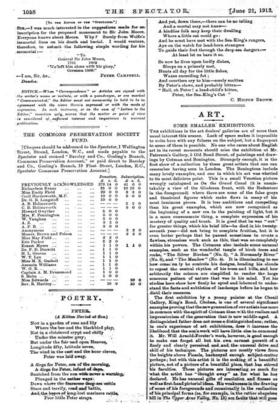ART.
SOME SMALLER' EXHIBITIONS.
THE exhibitions in the art dealers' galleries are of more than usual interest this season. Lack of space makes it impossible to write here with any fulness on the subject, but a fingerpost to some of them is. possible. No one who cares about English art in its rarest moments should miss the exhibition at Mr. Paterson's Gallery, 5 Old Bond Street, of paintings and draw- ings by Cotman and Bonington. Strangely enough, it is the first show of a collection by these great artists that one can remember having seen in London. The Boningtons include many lovely examples, and one in which his. art was whetted to its most delicious point. This is a small Venetian picture wrongly catalogued as On the Grand Canal (it is unmis- takably a view of the Giudecca front; with the 'Redentore in the- foreground) where there are none of the false greys and theatrical figures which make flaws in many of his most luminous pieces. It is less ambitious and compelling than his great examples, which are now recognized. as the beginning of a new era in the painting of light, bat it is a more consummate- thing, a complete expression of his mastery of quality and touch. It is good that he was " out " for greater things, which his brief life—he died in his twenty- seventh year—did not bring to complete fruition; but it is even better perhaps that he paused sometimes to create a flawless, stressless work such as this, that was so completely within his powers. The Cotanans also include some unusual examples, aueh as the wonderful tangle of birch trees and rocks, "The Silver Birches" (No. 3), "A Normandy River" (No. 8), and " The Meadow" (No. 4). It is illuminating to see how- ccmsenu ly he controls his designs, bending his clouds to repeat the central rhythm of his trees and hills, and how arbitrarily the colours are simplified to render the large sonorous pattern of nature that was in his mind. Yet his studies here show how finely he spied and laboured to under- stand the facts:and subtleties of landscape before _he began to distil their. essences: The first- exhibition by a young painter at the- Chenil Gallery, King's Road, Chelsea, is one of several significant examples proving that the new generation of our artists has more in common with thespirit of Cotxuan than with the realism and impressionism of the generation that' is now middle-aged. A . distinguished father does not mean a distinguished son; rather, in one's experience of art exhibitions, does it increase the likelihood that the-eon's work will have little else to commend it. Mr. Will Arnold-Forster's work, however, is good enough to_ make one forget all hut his own. °arae . pursuit of a finely and clearly perceived end--and.-the unusual drive and skill of his technique. The pictures are mostly views from the heights above Fiesole, hackneyed enough subject-matter perhaps ; but with this artist it is the making. of a beautiful picture, not of a picture of a beautiful place, that has stirred his faculties. These pictures are interesting as much for what the artist has " thought away " as for what he- has declared. He has unusual gifts of resolution and .fineese as well as first-band pictorial ideas. His weaknesses in the drawing of some of his foregrounds and occasionally in the realisation of his principal forms (as, for example, in the rather shapeless hill in The Upper. Arno Valley, No. 15), are,fedts that will Rase
• away as continued study reinforces his eye ; but his sense of design is there from the beginning, and that is the rarest thing. One looks forward with strong interest to this artist's future.
At the Dowdeswell Gallery Mr. Walter J. James has a collec- tion of pictures and etchings of considerable merit. Etching is now engaging so many men of talent that people demand from the etcher stronger evidence of a distinct personality and gift of hand than from practitioners in almost any other medium of art. Mr. James's The Black Cock (No. 45) comes nearest to such a proof, with its powerful silhouette and the close, nervous rendering of the body. The design falls off somewhat at the end of the tail, which becomes weakly naturalistic, and this slackening of the interest at some point that is important to the design rather than to the subject interferes with the success of many of his works. Where he is nearest to engraving he seems to be at his best, notably in The Carrara Mountains (No. 62). His oil and water-colour pictures vary in interest, as is natural in an exhibition that seems to cover many years of work, reaching their best in Cheviot from the Ottercups (No.9), with its fine expression of space and air and distant hills under rain-bursts, expressed in











































 Previous page
Previous page